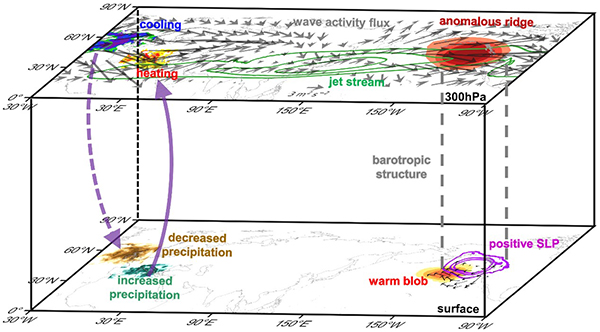The team led by Assoc. Prof. Shi Jian and Prof. Huang Fei from OUC’s College of Oceanic and Atmospheric Sciences and Frontiers Science Center for Deep Ocean Multispheres and Earth System made significant progress in its research on mid-latitude ocean-atmosphere interactions. It uncovered how the Atlantic Ocean and the Mediterranean Sea region trigger the high-pressure anomalies in the northern flank of the Northeast Pacific warm blobs from the perspective of mid-latitude atmosphere teleconnections, and published an article titled “Northeast Pacific warm blobs sustained via extratropical atmospheric teleconnections” in Nature Communications.

Warm blob is a persistent anomalous warming phenomenon in the mixed layer of the Northeast Pacific Ocean at mid-latitudes, which has devastating impacts on climate, ecosystems, and socio-economy. Over the past 10 years, frequent warm blobs in the Northeast Pacific have drawn wide attention. High-pressure anomalies on the northern side of the Northeast Pacific form a key atmospheric circulation system that triggers winter warm blobs. Previous research has revealed this physical mechanism by which high-pressure anomalies can be triggered in the tropical Pacific and the Arctic. However, influence from the mid-latitude region is still unclear.
Through thermo-dynamic diagnostic analyses and sensitivity experiments, the Mediterranean Sea and the North Atlantic Ocean are the two key Rossby wave regions triggering the high-pressure anomalies on the northern side of the warm blobs. In November, when there is a significant increase in precipitation in the Mediterranean and a decrease in the North Atlantic, it is possible to stimulate the Rossby wave train through diabatic heating/cooling and atmospheric convergence-divergence anomalies. The westerly rapids direct the fluctuating energy of this wave train to the northeast Pacific Ocean, which plays a crucial role in generating and sustaining high-pressure anomalies on the northern side of the warm blobs, thus resulting in stronger warm blobs in winter.
This research enriches the knowledge of the triggering mechanisms of the northern high-pressure anomalies of warm blobs from the perspective of cross-basin atmospheric teleconnections. It helps to clarify the relative contributions of different regions to the atmospheric circulation anomalies over warm blobs, improves the ability to predict the SST variability in the Northeast Pacific which is valuable for the climate prediction of North America and the entire Northern Hemisphere.